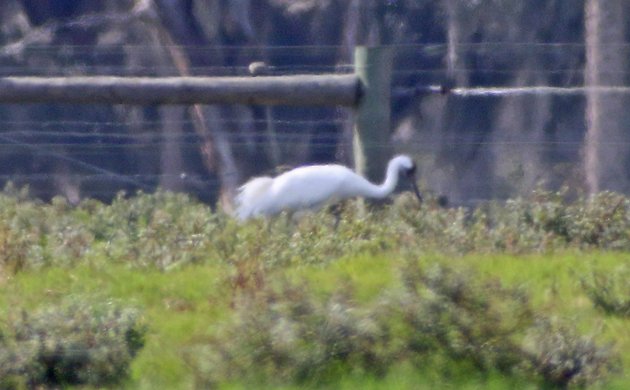
This year was my third year helping to lead trips at the Space Coast Birding and Wildlife Festival. Like my two previous visits I spent one day that I didn’t have to lead any field trips doing a run through central Florida looking for some of the specialty species of the region. The list includes Bachmann’s Sparrow, Red-cockaded Woodpecker, Crested Caracara, Snail Kite, and, oddly, Whooping Crane. On my previous trips I was successful on each and every species except for the crane. The Whooping Crane I hoped to see is one of the few remaining birds from the effort to introduce a non-migratory flock of cranes to central Florida, an effort that did not pay off.
From 1993 to 2004, biologists released 289 captive-raised whooping cranes into central Florida. Due to problems with survival, reproduction, and other challenges, a decision was made to stop releasing cranes into the non-migratory flock. However, studies of the surviving members of this flock will continue in order to provide more knowledge about the challenges they are facing.
As of 2008 only 31 of the 289 cranes released into central Florida were still alive. That number has continued to shrink. It is no wonder that the project was discontinued. Though Whooping Cranes have recovered greatly since their nadir of 23 total Whooping Cranes in 1941 as of 2011 there were only about 600. Continuing to release more birds into an environment that could not sustain them was a losing strategy.
Scientists decided to stop releasing cranes into the non-migratory flock for a variety of reasons, including problems with survival and reproduction, both of which have been complicated by drought. Additional considerations included shorter-than-expected life spans, scarcity of birds for release, project costs and the loss of habitat from development. The team felt that project resources and birds produced in captivity could be better used for other whooping crane releases as well as to maintain the captive flock.
One of the remaining birds is known to frequent Joe Overstreet Road, a dirt road that runs a few miles through sod farms and cattle pastures between Canoe Creek Road and Lake Kissimmee in Keenansville,about an hour south of Orlando. The strategy that I had to find the bird was the same unsuccessful strategy I had used on my two previous visits: drive slowly along Joe Overstreet Road, stopping frequently to get out and scan, and hope that a bright white bird that stands more than four feet tall wouldn’t be that tough to see. So, of course, I reached Lake Kissimmee without a Whooping Crane sighting. Somewhat despondent, I spent some time scanning the lake for other birds, a fairly fruitless practice in the strong wind whipping the lake up.
Resigned to once again missing a chance at seeing one of the world’s most spectacular and rare birds, I packed my gear back into my car and prepared to drive back to Canoe Creek Road and then north to East Lake Toho in search of Snail Kites. Only deus ex machina could possibly save my hopes now and deus ex machina appeared in the form of a fisherman wearing a painfully bright red shirt. He waved me down and I braced myself, expecting him to point out any of the several Bald Eagles I had already spotted. I rolled down my window and the first words out of his mouth were “Hi, you lookin’ for that Whoopin’ Crane?”
Was I? Was I? Yes, dear fisherman, yes!
“Well, he’s been hangin’ around out on Canoe Creek. Just drive to the end of this road and hang a left. The first farm on the left, where all the cattle are? He likes it there. He’s usually way back from the road, but he feeds from the cattle trough so he sticks around. I saw him there a couple of hours ago.”
I thanked the fisherman profusely and headed back out, barely pausing for a pair of Crested Caracaras that were terrorizing American Crows. I reached the end of Joe Overstreet Road, turned left on Canoe Creek Road, and pulled over when I reached the cattle farm. There, white plumage gleaming, was my first-ever Whooping Crane!
Sure, the looks were distant. And, yes, the setting, a cattle pasture, could have been more pleasant. But neither of those things mattered. I was looking at a Whooping Crane, a bird that came within inches of oblivion, a bird that anyone is extremely fortunate to see at all, a bird that embodies hope, at least for this birder.
I sat for quite some time, scoping the bird. It was in the company of some Sandhill Cranes, birds that looked drab and uninspiring by comparison. It fed. It walked. Once, it scratched its head. While I was watching the image started to get a bit blurry. There wasn’t a problem with my optics but with my eyes. I must have gotten some sand in them or something because they were tearing up. Yeah, sand…
Eventually, cognizent of being barely off the shoulder of a road that featured a high speed limit and frequent tractor-trailer trucks, I said my good-byes to the magnificent creature and headed north. I’ve seen a Whooping Crane! That is special, more so than any other sighting of any other bird that I’ve experienced.
…
10,000 Birds is a Scrub Jay-level sponsor of the 18th Annual Space Coast Birding and Wildlife Festival.
………


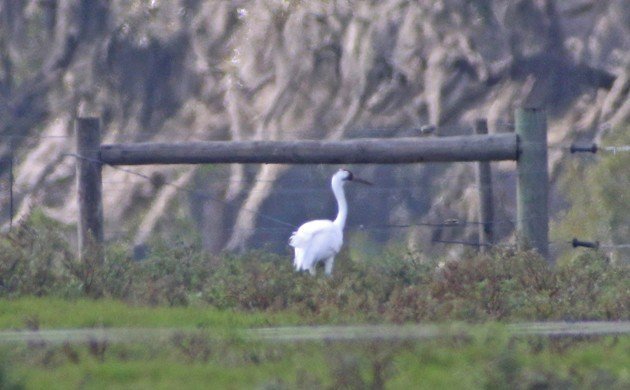




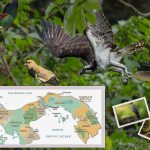
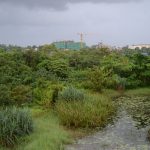

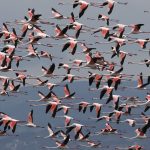



Congrats Corey! I too cried when I saw my first Whooping Crane. My photos are of an indistinct white blob surrounded by a hundred brown (sandhill) blobs, so you’ve got me beat there. Whoopers are incredibly special birds, aren’t they?
One among the Sandhill Cranes at Bosque del Apache 1989…no photos, but some friendly birders shared the views through their scopes! A special moment 🙂
Thrilled for all of you that have seen Whooping Cranes! What an amazing experience, thank you for sharing it with us. Let’s hope these magnificent birds rebound. #bucketlist
Dude, that is awesome. Congrats! Still need it, sure hope I can look for them next year.
They’re great!
And, yes, I guess my slightly distinct white blob is a bit better than an indistinct white blob.
@Patrick, you can look for it as there is only one withing reasonable striking distance of the festival and this is it.